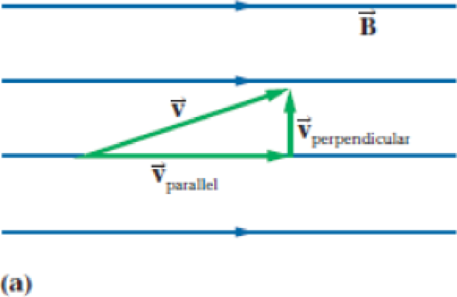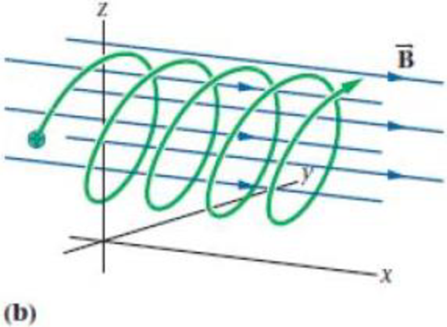
Helical Motion As a model of the physics of the aurora, consider a proton emitted by the Sun that encounters the magnetic field of the Earth while traveling at 4.3 × 105 m/s. (a) The proton arrives at an angle of 33° from the direction of


Want to see the full answer?
Check out a sample textbook solution
Chapter 22 Solutions
Physics (5th Edition)
Additional Science Textbook Solutions
Life in the Universe (4th Edition)
Physics for Scientists and Engineers: A Strategic Approach, Vol. 1 (Chs 1-21) (4th Edition)
The Cosmic Perspective Fundamentals (2nd Edition)
Tutorials in Introductory Physics
Glencoe Physical Science 2012 Student Edition (Glencoe Science) (McGraw-Hill Education)
Conceptual Physics (12th Edition)
- A particle moving downward at a speed of 6.0106 m/s enters a uniform magnetic field that is horizontal and directed from east to west. (a) If the particle is deflected initially to the north in a circular arc, is its charge positive or negative? (b) If B = 0.25 T and the charge-to-mass ratio (q/m) of the particle is 40107 C/kg. what is ±e radius at the path? (c) What is the speed of the particle after c has moved in the field for 1.0105s ? for 2.0s?arrow_forwardIn Niels Bohr’s 1913 model of the hydrogen atom, the single electron is in a circular orbit of radius 5.29 × 10−11 m and its speed is 2.19 × 106 m/s. (a) What is the magnitude of the magnetic moment due to the electron’s motion? (b) If the electron moves in a horizontal circle, counterclockwise as seen from above, what is the direction of this magnetic moment vector?arrow_forward(a) At what speed will a proton move in a circular path of the same radius as the electron in Exercise 22.12? (b) What would the radius of the path be it the proton had the same speed as the electron? (c) What would the radius be if the proton had the same kinetic energy as the electron? (d) The same momentum?arrow_forward
- A uniformly charged ring of radius R = 25.0 cm carrying a total charge of 15.0 C is placed at the origin and oriented in the yz plane (Fig. P24.54). A 2.00-g particle with charge q = 1.25 C, initially at the origin, is nudged a small distance x along the x axis and released from rest. The particle is confined to move only in the x direction. a. Show that the particle executes simple harmonic motion about the origin. b. What is the frequency of oscillation for the particle? Figure P24.54arrow_forward(a) Triply charged uranium-235 and uranium-238 ions are being separated in a mass spectrometer. (The much rarer uranium-235 is used as reactor fuel.) The masses of the ions are 3.90×10−25 kg and 3.95×10−25 kg , respectively,and they travel at 3.00×105 m/s in a 0.250-T field. What is the separation between their paths when they hit a target after traversing a semicircle? (b) Discuss whether this distance between their paths seems to be big enough to be practical in the separation of uranium-235 from uranium-238.arrow_forward(a) Triply charged uranium-235 and uranium-238 ions are being separated in a mass spectrometer. (The much rarer uranium-235 is used as reactor fuel.) The masses of the ions are 3.90 X 10-25 kg and 3.95 X 10-25 kg,respectively, and they travel at 3.00 X 105 m/s in a 0.250-T field. What is the separation between their paths when they hit a target after traversing a semicircle? (b) Discuss whether this distance between their paths seems to be big enough to be practical in the separation of uranium-235 from uranium-238.arrow_forward
- The scalar and vector potentials are defined as follows: V(x,y,z,t) = 0 Ã(x, y,²,1) = μ₁4, (ct —x)  What are the electric and magnetic fields? (a) Ẽ = 0 and 5 = — 144Î ——μ‚¾‚¸Â and B =——-44,³ (b) E=4ck (c) E = — -—-14,4¸¢Â and B = 1⁄- 14,4,J (d) E = 0 and B=0arrow_forwardA positively charged particle slides off a frictionless and smooth surface with initial X X X X X X X X speed v, =v, . It then enters into a region with X X X X X x x x X uniform magnetic field pointing into the page. X X X X x x x x X x x x x x X x x x The particle eventually hits the ground with final speed v, air time and range S · The particle slides off the edge again with identical initial speed, but this time without the magnetic field. The particle then hits the ground with final speed v,, air time t, , and range s,. Determine the relationships between v, and v,, t, and t, , as well as s, and s, (3 marks). Please note that no calculation is needed. You were to provide the relationship in the sense that whether one variable is greater than, smaller than, or equals to the other one (>, <, or =). Provide a rough explanation (3 marks).arrow_forwardA negatively charged particle (m = 5.0 g, q = -70 microC) moves horizontally at a constant speed of 30 km/s in a region where the free fall gravitational acceleration is 9.8 m/s2 downward, the electric field is 700 N/C upward, and the magnetic field is perpendicular to the velocity of the particle. a) What are the directions of the electric and magnetic forces on the particle? O Both forces are upward O Electric force downward; magnetic force upward O Both forces are downward O Electric force upward; magnetic force downward b) What is the magnitude of the magnetic field in this region?arrow_forward
- O When electrons are discharged from an electron gun, their motion can be controlled by: A additional electric fields only B additional magnetic fields only C additional electric and magnetic fields D the motion of the electrons cannot be controlled 00) A single positively charged particle with a charge of +1.6 x 1019C travels at a velocity of 30ms at an angle of 30 to a magnetic field, B, of strength 6.0 x 10-T. What is the magnitude of the force the particle will experience from the magnetic field? 000)A single positively charged particle with a charge of +1.6 x 10-19C travels at a velocity of 60ms at an angle of 50* to a magnetic field, B. The force on the particle is 1.5 x 1024 N. What is the magnitude of the magnetic field acting on the charged particle?arrow_forwardA proton circulates in a cyclotron, beginning approximately at rest at the center. The electric potential difference between the dees is 400V. What is the proton's kinetic energy after completing 100 passes through the gap?arrow_forwardAn electron in J. J. Thomson's charge-to-mass apparatus moves perpendicular to a B-field along a circular path of radius 13.10 cm. If imposition of an E-field of 17.80 kV/m makes the path straight, what is the value of B?arrow_forward

 Principles of Physics: A Calculus-Based TextPhysicsISBN:9781133104261Author:Raymond A. Serway, John W. JewettPublisher:Cengage Learning
Principles of Physics: A Calculus-Based TextPhysicsISBN:9781133104261Author:Raymond A. Serway, John W. JewettPublisher:Cengage Learning Physics for Scientists and Engineers: Foundations...PhysicsISBN:9781133939146Author:Katz, Debora M.Publisher:Cengage Learning
Physics for Scientists and Engineers: Foundations...PhysicsISBN:9781133939146Author:Katz, Debora M.Publisher:Cengage Learning College PhysicsPhysicsISBN:9781938168000Author:Paul Peter Urone, Roger HinrichsPublisher:OpenStax College
College PhysicsPhysicsISBN:9781938168000Author:Paul Peter Urone, Roger HinrichsPublisher:OpenStax College



